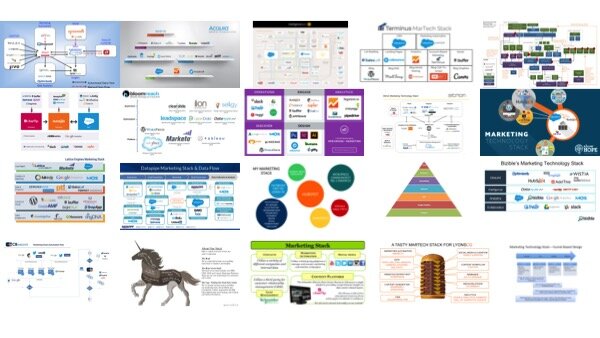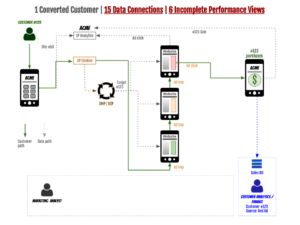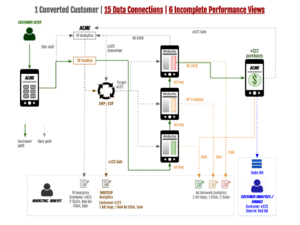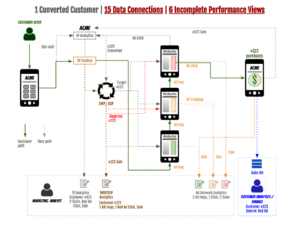Thank you, Google News, for surfacing a great article on Friday. If you haven’t read Dr. Augustine Fou’s piece in Forbes on Aug 20, 2020, The link is here. He discusses advertising measurement, analytics and attribution, and points to how trivial compromising these systems are for fraudsters. It’s true – fraud remains a threat to digital marketing attribution. We surfaced a small example of some nefarious behavior that hits close to home in a previous blogpost. But fraud isn’t new, nor unique to digital marketing. Insurance can defraud, but you shouldn’t drive around without it. Hucksters peddle miracle cures, but you should still trust your doctor. And though your marketing & media attribution datasets are vulnerable to impropriety, attribution fraud exposure is far from digital marketing’s weakest link.
The truth is your current digital marketing technology strategy, executed as intended, wastes more money than fraudsters could ever dream of stealing from you. Better mar-tech design & first-party data principles would easily recoup material wasted investments and re-direct them into gains for your business.
How Can That Be?
You haven’t even seen our strategy – how can you say it’s so bad?
Fair question. First of all, we’ve cheated a bit. We have seen your strategy. Our marketing technology research has analyzed the mar-tech ecosystems & active deployments for over 5,000 companies across more than 30 industries. If you are reading this blog, there’s a good chance we’ve analyzed your deployment already. What have we learned? A lot. For instance:
-
You probably manage or execute digital marketing through 3 or more demand-side (DSP) or data management platforms (DMPs). Industry averages hover between 3-5, depending on your vertical.
-
These 3 + DSPs & DMPs serve programmatic media and marketing through a minimum of 5-8 unique ad networks or exchanges. Many companies target customers using more than 20 ad networks. The average remains above 10.
-
These ad networks and exchanges serve varying content, powered by varying 3rd-party cookies and tags, in multiple ad slots on the same web pages to the same exact users at the same time. This overlap occurs virtually constantly. In practice, there are no industry standard measurement protocols – every customer can set cookie windows of varying lengths, on varying web and app content segments, connecting datasets to varying 3rd-party data onboarders. The permutations go on and on.
-
These 3rd-party audiences and analytics platforms measure the same business event multiple times, sometimes 20 or more times – and all take simultaneous credit for driving a single business outcome.
-
Your analysts, practitioners and executives are mired in report-overload, and must have immediate answers and instincts for “what data to believe”. In that environment, matters of fact immediately become matters of bias and judgment.
Simple Customer Paths Complicated By Your Mar-Tech
Slideshow above: The customer journey and marketing data paths through an entire Mar-Tech ecosystem, when functioning as intended. Note that even the simplest example – a single customer making a single purchase -requires 15 unique and successful data connections. It also produces 6 distinct views of performance, all incomplete pictures of the full consumer journey.
The example above visualizes a single customer journey for our example business, ACME. ACME has a lean marketing technology stack by industry standards – they use one site analytics platform, one data management platform, target customers using three ad networks, and measure all sales in a single system of record / cloud-based data warehouse.
As you move through the slides, you can see that ACME’s financial analyst gets one version of sales & attribution data, which differs slightly from any of the datasets available to the marketing analyst. Even more troubling, the marketing analyst has five different views of performance, all of which have different versions of the customer’s path to purchase, giving different clues towards true media impact and attribution.
On top of that, measurement isn’t the only multi-variate problem requiring expertise and seamless execution. Note that the DMP must both match & distribute audience data collected from on-site behavior to ad networks capable of targeting customer #123, but later it must collect customer sales information correctly and use that same information to later suppress future ads to customer #123.
Questions to ask yourself right now:
- Are your marketing analysts, finance & operations teams aware of every data discrepancy between marketing measurements located across your various site analytics, ad analytics, and data warehouse reports? Do they know how to reconcile these measurements and build valid heuristics and attribution models?
- Do you know how your measurement reports accrue data? What cookies collect the data? What rules govern their tabulation and what data isn’t included in each report?
- Does your practitioner and execution team know what reports are valid measures of true investment ROI, which metrics can power bid automation, which metrics can’t and why?
- Do you know how your first-party data moves throughout your marketing technology ecosystem? Do you know how your third-party data management platforms and ad networks are ingesting audience data for media targeting, or audience suppression?
- Could you place every aspect of your marketing technology stack into one of the example visuals above?
If you answered “no” to any of the questions above, a better strategy guided by Bonsai’s marketing technology audits, dataflows and optimal utilization designs would improve your marketing effectiveness and overall technology ROI dramatically. Let’s talk.
The “Stackies” Are Stuck

Image credit: Chief Mar-tec (chiefmartec.com)
Over the years, the marketing technology industry has become so famously convoluted and complicated, there’s even a niche for companies that specialize in lampooning the ecosystem. As early as 2015, Chief Mar-Tech ran contests for companies who could visually communicate their marketing technology data operations ecosystem for their own company. The theme you’ll see when looking at many of these examples:
- There’s no discernible pattern – some are good, some are bad, all of them are unique and
- Though the visuals remain highly complex, they often don’t communicate any of the functional dataflows, agents and stakeholders throughout the system.
For further reading on this, I recommend checking out Ben Bloom’s work @ Gartner. The punchline – more mar-tech isn’t always better.
As we head into the fall of 2020, please don’t look at your existing technology stack and think: “We need to simplify our IT: let’s bring in some demos for some of the new all-in-one marketing clouds.” If you bring yet another system into your stack, I promise you’ll have a bigger mess on your hands – not a smaller one – in 2021.
Let’s decode your current technology stack together.
- Learn every platform you currently pay for, and the explicit functions it delivers – or doesn’t deliver.
- See how customer interaction datasets build and flow through your entire stack.
- Understand how business outcomes are reported inside your data lake, and how that translates to reporting you receive from third-party platforms.
- See how audience information flows – both from and to your marketing touchpoints.
- Learn how your teams currently utilize your stack: which aspects they know well, and which aspects they need further training on.








